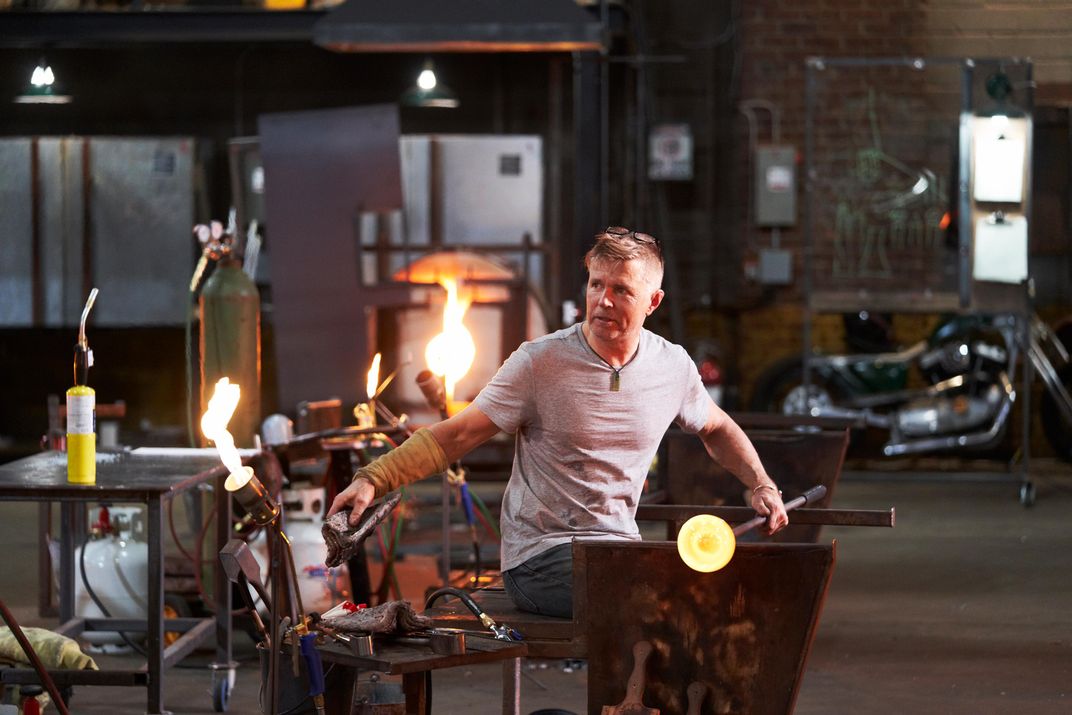The Spectacle and Drama of Netflix’s New Glassblowing Show Will Shatter Your Expectations
“Blown Away” showcases the incredible art form in an innovative reality competition series
:focal(995x721:996x722)/https://tf-cmsv2-smithsonianmag-media.s3.amazonaws.com/filer/05/19/0519da1e-bea5-499e-995e-be85868d82c9/annette_sheppard_generic_3_courtesy_of_marblemedia.jpg)
“When I say I’m a glassblower, people think I make pipes and bongs,” says Katherine Gray with a laugh. A professor of art at California State University, San Bernadino, Gray is the chief judge on “Blown Away,” a new Netflix reality competition centered around the dramatic, sweaty, creative process of glassblowing. Far beyond the paraphernalia Gray’s interlocutors ask about, the art form demands incredible skill and produces stunning works worthy of any museum collection.
Adds Gray of the stereotypes she encounters, “Or, they think I make work like Dale Chihuly. Which is not a bad comparison, and I’m glad people know of his work. But Chihuly’s work is just one—albeit, very famous—interpretation of glass. This show will showcase the huge range of work that’s being made in glass, and what different generations are doing with it.”
Premiering this Friday, July 12, the show is the first-ever competition series to focus on glassblowing. In each episode, artists create a finished piece in a matter of hours, each hoping to avoid elimination and emerge the winner, who receives a $60,000 prize and a coveted artist residency at the Corning Museum of Glass.
Glass artists, as well as many art institutions, hope that the show will raise public perception of glassblowing as a fine art—a perception that has been diminishing in recent years, according to Cybele Maylone, executive director of Connecticut’s Aldrich Contemporary Art Museum and former executive director of UrbanGlass in Brooklyn, New York.
The first, simple glass objects were made before 2000 B.C., in ancient Mesopotamia. In ancient Rome, glass makers discovered that they could inflate glass by blowing into a tube, making it much easier to create vessels. During the Renaissance, Venetian “maestros” perfected the art of glassblowing, making ornate vessels such as dragon-stem goblets. The Industrial Revolution saw increased production of luxury goods, and factories full of artisans working with glass popped up all over Europe and the United States; machines made it possible to manufacture glass, and glass tableware became affordable and accessible to the masses. Then, in the 1960s, the studio glass movement brought Venetian maestros to the U.S. to teach their techniques, launching a number of successful artists, including Chihuly.
But now things have changed. A 2015 report produced by the Glass Art Society and Chihuly Garden and Glass suggested that, despite public enthusiasm for glassmaking, galleries are concerned that young art collectors were less excited about the medium. Glass art isn’t holding its value well on the secondary market, Maylone says.
/https://tf-cmsv2-smithsonianmag-media.s3.amazonaws.com/filer/76/61/766163e0-bea2-444e-b432-340b77ef5fed/alexander_rosenberg_generic_7_courtesy_of_marblemedia.jpg)
At the same time, glassblowing demonstrations—the “spectacle” of glassmaking, as Maylone puts it—have become a popular pastime. The process is mesmerizing, jaw-dropping and nerve-wrecking. (The Corning Museum of Glass partnered with Celebrity Cruises to bring glassblowing demos to their ships.) Onlookers watch as artists extract molten glass from a 2,000-degrees-Fahrenheit furnace with a long metal blow pipe. Using metal tools, they then sculpt the material, perhaps applying color or more glass, and reheat the glass periodically in another furnace called a “glory hole.” At any point, the entire vessel could break off the pipe and shatter. Many glass artists talk about how mistakes shape their work. Glass is hard to control, so, often artists improvise as their works develop organically, bending their creativity to match where the material takes them.
So it’s not just great art, it should make for great television.
Maylone hopes that “the show will highlight more than just the process, allowing viewers to learn about the artists and their points of view.”

One of the reasons that the reality competition genre pioneered by the likes of “Project Runway” and “Top Chef” has never touched on the art form is that glassblowers need space, says Gray. It was filmed in the largest glass blowing facility in North America, custom-built to accommodate 10 glass blowers working simultaneously. The 10 competitors range from 20-something, recent art-school graduates to 50-something artists who have been working with glass for decades and have exhibited and sold their work. Assignments include creating a self-portrait based on a photo, a “Pop Art”-style sculpture, a piece of lighting, and a wine decanter with a goblet.
Compounding the drama is that the artists have only hours—four, six or eight, depending on the challenge—to complete their work, which then cools gradually in an annealer before being transferred to a gallery space for evaluation. “The biggest challenge for me was working so fast,” says contestant Janusz Poźniak, a Seattle-based artist who has been working with glass for more than 30 years. “Usually, my ideas evolve slowly in my mind and I sketch them out. Then, in the hot shop, it can take me weeks to refine the techniques to get the precise result that I’m going for.”

On the other hand, contestant Deborah Czeresko, who has also been honing her skills as a glass blower for several decades, enjoyed the fast pace: “It was invigorating and very meaningful to me, to learn that I could produce high-quality work that quickly.”
Women’s equality is a major theme in Czeresko’s work. When glass blowing took off as an art form in the U.S. the 1960s, there was a lot of machismo, and a lot of focus on a technical prowess and athleticism, she says. “So, I’ve long been interested in women occupying these spaces that involve physicality, where they’re perceived as not belonging. I wanted to make glass the great equalizer.” She applied to be on the show, she says, “because it seemed like an unprecedented platform for my artistic voice.”
Half of the competing artists are women, and the representation is welcome. While many women work with glass, they often don’t receive the same attention from gallerists and museums as their male counterparts. “Glass is often associated with a certain type of male genius [like Chihuly], both in Europe and the United States,” Maylone observes. “Gray and Czeresko are both incredible female artists who have changed the field and the medium.”
Gray, Poźniak and Czeresko all say they hope the show will increase the public’s understanding of how glass art is made, and ultimately, result in greater appreciation, and increased sales, for the medium. Many glass blowers take on commercial assignments in order to make a living—Czeresko has a custom lighting line, and has fabricated pieces for other artists, such as Kiki Smith—so carving out time to develop their own artistic voices is a constant challenge. The $60,000 prize and residency will likely be transformative for the winner. Starting Friday, Netflix watchers can find out which glass blower emerges victorious, and which ones have their dreams, well, shattered.

